Accelerated Techniques for Composting Kitchen Waste
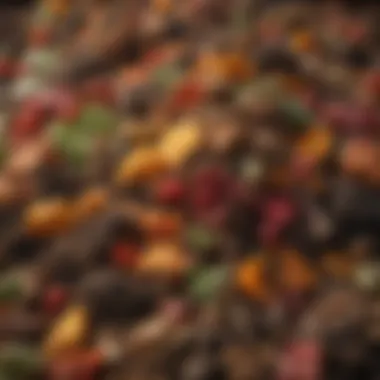

Intro
In an era where environmental awareness has become crucial, the way we handle our kitchen waste plays a significant role. Composting kitchen scraps not only reduces landfill contributions but also yields rich organic material to boost garden health. Acceleration of this natural process has piqued interest among novice composters and green thumbs alike. Understanding how to speed up composting can create a more efficient and rewarding gardening experience.
This article dives into various strategies to make composting quicker and more efficient. We address everything from basic principles to advanced techniques. Whether you’re tossing potato peels or mixing in coffee grounds, knowing the right methods can shift your composting game into high gear.
Understanding the Basics
Before delving into quickening techniques, it’s essential to grasp the fundamentals of composting. Composting is the breakdown of organic material into nutrient-rich soil through microbial activity.
Key Components of Compost
- Green Materials: These are rich in nitrogen and include vegetable scraps, grass clippings, and coffee grounds.
- Brown Materials: Composed of carbon, brown materials include dried leaves, twigs, and shredded paper.
- Air: Microbes require oxygen; therefore, proper aeration is vital.
- Moisture: Think damp sponge. Not soaked, but just enough to support decomposition.
By balancing these elements, you'll create the perfect environment for speedy composting.
Techniques to Accelerate Composting
Several tried-and-true methods can help speed up the breakdown of your kitchen waste. Here are some of the most impactful:
1. Shredding Materials
Breaking down waste into smaller pieces increases surface area, which allows microbes to work faster. A food processor can easily handle this task for soft items, and a shredder is perfect for brown materials.
2. Maintaining Correct Ratios
Aim for a carbon to nitrogen ratio of about 30:1. This ratio fuels the microbial activity essential for decomposition. If you notice your compost pile isn't breaking down quickly, adjust the balance as needed.
3. Turning the Pile Frequently
Aerobic bacteria thrive on oxygen. Turning your compost pile every week or two helps mix materials and introduces new air, promoting faster decomposition.
4. Adding Compost Activators
Using activators or inoculants can introduce high concentrations of microbes. Products like compost starter, or even adding a handful of finished compost, can supercharge the process.
"A well-balanced compost heap is like a symphony, with each component playing its part to create a harmonious finish."
5. Temperature Monitoring
A hot compost pile is a happy pile. Keep an eye on the temperature; ideally, it should reach at least 130°F to 160°F to ensure the breakdown of materials is efficient. You can use a compost thermometer for monitoring.
6. Moisture Levels
Too much moisture can lead to anaerobic conditions, while too little slows down the process. Strive for consistently damp—not soggy—conditions.
Through these techniques, anyone can elevate their composting efforts to a level that not only benefits their own garden but also contributes positively to the environment.
The Fundamentals of Composting
Composting is much more than just tossing organic matter into a pile and hoping for the best. Understanding the fundamentals of composting is paramount for anyone aiming to efficiently manage kitchen waste. In this section, we’ll delve into what composting truly entails and how it can be a game changer not only for your garden but also for the environment.
Understanding Composting
At its core, composting is nature’s way of recycling. It involves the decomposition of organic materials, transforming them into a nutrient-rich soil amendment known as compost. This process can be likened to cooking: you need the right ingredients, the proper conditions, and a little bit of patience.
- The Basics: Composting typically requires a mix of green materials, like fruit scraps and grass clippings, and brown materials, like dry leaves and paper. When layered correctly, these components break down through the action of microorganisms, fungi, and other decomposers.
- Aeration and Moisture: Think about how a sponge absorbs water. Similarly, compost needs to retain a balance of moisture and air. Without sufficient aeration, the compost can become anaerobic, deterring beneficial aerobic microbes, which are crucial for decomposition.
- Time Factor: Composting is not an overnight affair. Depending on the method and conditions, it can take weeks to months to yield finished compost. However, with the right techniques, this time can be significantly reduced, allowing you to harness those nutrients sooner.
Benefits of Composting Kitchen Waste
The merits of composting kitchen waste extend well beyond the backyard. Here’s why becoming a composter reaps rewards:
- Waste Reduction: Composting diverts organic waste from landfills. By recycling kitchen scraps, you cut down on landfill waste, helping the environment in the process. A little effort can lead to big impacts.
- Enriching Soil: Compost enhances soil structure, providing vital nutrients that boost plant growth. Think of it as feeding your soil instead of just watering it. It improves moisture retention, aeration, and promotes beneficial microbial activity.
- Cost Efficiency: Utilizing homemade compost reduces the need for chemical fertilizers and expensive soil amendments. It’s budget-friendly while also ensuring your plants get what they need.
- Environmental Benefits: Composting supports the fight against climate change. By reducing methane emissions from landfills and promoting healthier plants that sequester carbon, you’re playing an active role in environmental sustainability.
"Composting is a simple act that can have profound impacts on the environment, transforming our waste habits and supporting sustainable living."
By grasping the fundamentals of composting, individuals are not only setting the stage for successful kitchen waste management but also contributing positively to environmental wellness. As we proceed through this guide, we'll explore further techniques and components that accelerate the composting process.
Essential Components for Quick Composting
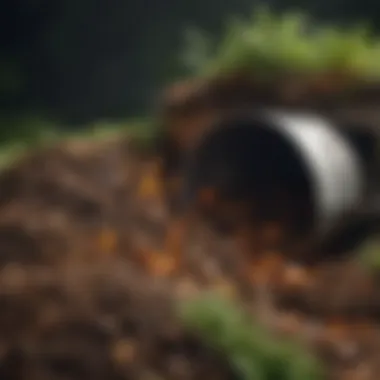
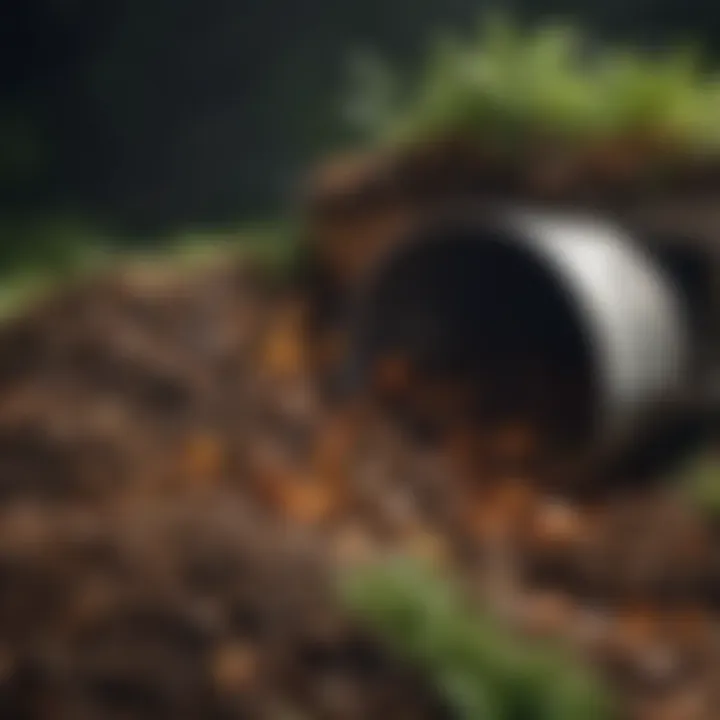
To truly accelerate the composting process, it’s vital to grasp the essential components that serve as the backbone of effective compost systems. These elements can turn your kitchen scraps into nutrient-rich compost in record time. In the fast-paced world we live in, embracing quick composting not only reduces waste but also contributes to sustainable environmental practices. Understanding these components helps in creating a thriving compost environment, with each contributing factor playing its part in the intricate dance of decomposition.
Nitrogen-Rich Materials: Greens
Nitrogen-rich materials, often referred to as "greens," are a cornerstone of your compost mix. These include fresh vegetable scraps, coffee grounds, and grass clippings. They contain high levels of nitrogen, which is essential for microbial growth. When you introduce greens into your compost pile, you're essentially fueling the microorganisms that do the heavy lifting during decomposition.
However, balance is key. If you dump in too many greens without sufficient carbon-rich materials, known as "browns," the result could be a soggy, odorous mess rather than fertile compost. Ideal greens produce vibrant colors, fresh aromas, and nutrients to speed up the decomposition process. Strive for a ratio of about 2:1, greens to browns, to maintain that happy medium.
Carbon-Rich Materials: Browns
On the flip side of the nitrogen equation are carbon-rich materials, or browns. Items like dried leaves, straw, shredded newspaper, and cardboard belong to this category. These components play a critical role by providing the energy needed for the composting microbes. Think of browns as the backbone that supports the leafy greens; without them, the compost structure becomes imbalanced.
Layering your compost with browns not only enhances aeration but also helps in controlling moisture. A layer of shredded leaves or straw can effectively absorb excess moisture, providing the perfect bed for microbes to thrive. Always remember, too many greens can lock in moisture, leading to anaerobic conditions—this makes browns indispensable.
Moisture Balance: The Key to Decomposition
The amount of moisture in your compost is often the unsung hero in the decomposition process. Too much moisture can suffocate the beneficial microbes, while too little can halt your composting efforts altogether. Striking the right moisture balance can make or break your composting adventure.
Aim for a moisture level that feels like a wrung-out sponge. You want it damp, not drenched. To monitor this, simply squeeze a handful of your compost mix: a few drops of water should escape, but it shouldn’t drip. If your compost leans toward the dry side, consider sprinkling some water, or adding more greens; if it’s too wet, mix in more browns or aerate your pile regularly to promote evaporation.
“In composting, achieving the right balance between nitrogen, carbon, and moisture creates an ecosystem where nature can work its magic.”
Choosing the Right Composting Method
Selecting the right composting method is a crucial step in optimizing your kitchen waste breakdown process. Each method has its own set of benefits and considerations, and understanding them can lead to faster decomposition and healthier compost. Knowing what to choose can save time and effort while also improving the quality of your end product. It’s like picking the right tool for the job; the right method can make all the difference in how effectively you manage your organic waste.
Traditional Compost Pile
The traditional compost pile is perhaps the most popular and time-tested method among gardeners. It involves creating a heap or bin outdoors where materials can decompose with the help of natural bacteria, fungi, and other microorganisms. Typically, you layer green and brown materials, maintaining a ratio of about 1:3, respectively. This method is often favored for its simplicity and effectiveness.
However, traditional piles require some effort in terms of aeration. Turning the pile every few weeks can keep the microorganisms thriving by increasing oxygen flow, accelerating the decomposition process. A well-structured, moisture-balanced pile can produce rich compost in a matter of a few months.
Vermicomposting: Harnessing Worms
Vermicomposting, or worm composting, is gaining traction as a superb option for quick composting in smaller spaces. By using red wiggler worms, you can turn kitchen scraps into nutrient-rich fertilizer in a matter of weeks. This method is not just efficient but also an excellent solution if you live in an apartment or have limited outdoor space.
The worms not only break down waste but also create castings, which are packed with essential nutrients that help plants prosper. However, it’s important to manage the moisture and avoid adding items that could harm the worms, such as citrus peels or onions. Successful vermicomposting can lead to rich, dark compost that even those with limited gardening experience can appreciate.
Bokashi Composting: An Alternative Approach
Bokashi composting offers a different angle to kitchen waste management. This method utilizes a special fermentation process with the help of effective microorganisms. It’s a great option for those who wish to compost meat and dairy products, which are typically not recommended in conventional composting methods.
In Bokashi composting, food waste is layered with Bokashi bran in a sealed container, creating anaerobic conditions that accelerate fermentation. Within a couple of weeks, your kitchen scraps will transform into an organic matter that can then be buried in the soil to enrich it further.
This method has a shorter wait time and gives off a less pungent smell compared to traditional composting, making it more user-friendly for those reluctant about compost odors. While the fermentation process may seem unusual, it serves as an innovative way to embrace zero waste.
Choosing the right composting method can be the key to unlocking a thriving garden and effectively managing kitchen scraps, leading to a more sustainable living environment.
Steps to Create a Compost System
Creating an effective compost system is an essential step toward turning your kitchen waste into nutrient-rich compost. This guide answers the call for straightforward, practical solutions that cater to both beginners and seasoned composters. Engaging in composting not only helps in reducing landfill waste, but it also contributes to healthier garden soil, creating a sustainable loop between consumption and enrichment.
Selecting an Ideal Location
Location is more than just a spot you can find in your backyard; it’s fundamentally about accessibility and efficiency. You want a place that balances sunlight and shade, allowing for proper microbial activity while preventing the compost from becoming too dry or too wet. Look for an area with good drainage as puddles can lead to undesirable odors and attract pests.
Consider an accessible area close to your kitchen—perhaps just a few steps away. Having this makes it easier to toss in scraps without putting too much effort into the chore. Keep in mind, the easier the system is to access, the more likely you are to keep it going.
Layering Materials for Optimal Breakdown
Layering is one of those tricks of the trade that ensures compost material breaks down quickly and efficiently. The general idea is to alternate between green materials, like fruit peels and vegetable scraps, and brown materials such as dried leaves and twigs. This layering not only provides the right nutrient balance but also encourages aeration throughout the pile.
- Greens: These materials are rich in nitrogen. Collect things like coffee grounds, grass clippings, and egg shells.
- Browns: Rich in carbon, items like cardboard, paper, and dry leaves belong here.
Aim for a ratio of 2:1, or even 3:1, browns to greens. This blend accelerates the decomposition process, turning your kitchen scraps into compost much faster.
Maintaining Aeration and Turnover
Once your compost system is in place, maintaining aeration is crucial. This ensures that oxygen flows through the pile, allowing for aerobic decomposition which is faster and more efficient than anaerobic processes. Regularly turning the compost pile can make a significant difference in its breakdown speed.
Here are some pointers on how to keep the aeration flowing:
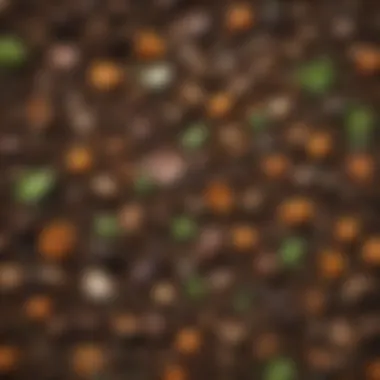

- Turn Every Few Weeks: A pitchfork or compost turner can come in handy. Be sure to mix the inner sections with the outer to maintain an even temperature.
- Monitor the Moisture: If it feels too dry, add water. Alternatively, if it's too wet, toss in more browns.
- Observe the Temperature: A hot pile, around 130°F to 160°F, indicates that your compost is hot and breaking down efficiently.
Ultimately, each of these steps contributes to a composting system that produces quality compost in less time, making your gardening endeavors more fruitful. Adjust these techniques to fit your particular conditions, and keep your composting journey enjoyable and rewarding.
Monitoring and Troubleshooting Your Compost
Monitoring and troubleshooting your compost is like being a caretaker for a small ecosystem. It’s essential for ensuring that your compost isn’t just decomposing but thriving effectively. A successful compost system doesn’t just happen; it requires observation, attention, and adjustments based on what you notice.
By closely monitoring your compost pile, you can catch issues early before they become major setbacks. Each sign from your compost can reveal its health status—whether it’s cooking along nicely or in dire need of intervention. Proper monitoring can also help you to ensure that you’re getting the best possible nutrient-rich compost for your garden.
Understanding what a healthy compost looks like will not only hone your composting skills but will also give you insights into how the natural world works.
Signs of Healthy Composting
Recognizing the signs of a flourishing compost heap can be a rewarding experience. Here are some indicators to look out for:
- Temperature: A well-balanced compost pile will generate heat during decomposition. If you check the temperature and it’s between 130°F to 160°F (54°C to 71°C), give yourself a pat on the back—you’re doing great! This warmth indicates the microbial activity needed to break down materials.
- Smell: A healthy compost should have a pleasant, earthy smell. If it starts to resemble rotten eggs or has a sour odor, that’s a sign of problems. It might mean there’s not enough air or too much moisture.
- Moisture Levels: Your compost should feel like a damp sponge. It shouldn’t be too wet or too dry. If it crumbles when you squeeze it,add a little water, but if it oozes, you might need to add more dry materials.
- Worm Activity: If you see worms moving about, that’s a good sign! These little creatures are nature’s recyclers and a welcome addition to your compost pile.
Monitoring these signs closely will help you adjust your strategies. For instance, if your compost isn't heating up, you could try mixing in more nitrogen-rich materials.
Common Issues and Solutions
Sometimes, despite your best efforts, compost can face hiccups on its journey to becoming nutrient-rich black gold. Here’s a look at some common issues and their simple fixes:
- Bad Odors: If your compost stinks up the place, it might be a victim of anaerobic conditions. This happens when there's too much wet material or not enough airflow.Solution: Mix in dry materials like leaves or cardboard and turn the pile to aerate it. This should help dispel the offending odors.
- Too Dry: If your compost looks crumbly and dusty, it’s starved for moisture. Just like plants, your compost needs water to thrive.Solution: Lightly water the pile until it reaches that perfect moisture balance.
- Pest Invasion: Sometimes critters you didn’t invite can crash the party. Rodents or other pests can smell food scraps and decide to settle in.Solution: Ensure your compost bin has a secure lid. Additionally, steer clear of composting meats or oils that might attract unwanted guests.
- Slow Decomposition: If your compost is dragging its feet, check the balance of materials. Perhaps it's high in browns or too compact.Solution: Turn the pile more often and consider shredding larger materials to enhance airflow.
In summary, being vigilant and responsive can make all the difference. With a little effort and attention, you can keep your compost healthy and productive—ensuring that each scoop contributes to a vibrant garden.
Using Compost Effectively
Using compost effectively is crucial for anyone seeking to enhance their gardening experience and contribute positively to the environment. When done right, composting brings a wealth of organic matter into the soil, fostering healthier plants and ultimately improving the yield of fruits and vegetables. Not only does it recycle kitchen waste, but it also plays a vital role in reducing landfill contributions, aiding in sustainable waste management. To make the most out of your compost, it’s important to recognize how and when to apply it effectively.
When to Use Your Compost
Timing is everything in gardening, and knowing when to use your compost can shape the growth of your plants significantly. It’s best to apply compost in the following scenarios:
- Spring Preparation: As the snow melts and the soil begins to warm, the spring is an ideal time to incorporate compost. Mixing it into the soil before planting establishes a rich nutrient base for new growth.
- During Planting: For specific crops, like tomatoes or peppers, adding compost during planting helps provide that initial boost of nutrients. A handful placed in the planting hole can make a notable difference.
- Topdressing: Throughout the growing season, you can also apply compost as a topdressing. This method replenishes nutrients and moisture in the garden bed, benefitting the plants immediately without disrupting their root systems.
The health of the compost itself also suggests when to use it. Compost should be dark, crumbly, and have a pleasant earthy smell. If you notice a lot of recognizable materials or a strong odor, it might still need time to mature.
Incorporating Compost into Your Garden
Once you’ve deemed your compost ready for use, the next step is effective incorporation into your garden. Here are some tried and tested methods:
- Soil Amendment: Mix the compost well into the existing soil to improve its texture and nutrient content. This not only aids in water retention but also enhances soil aeration, reviving compacted earth.
- Mulching: Spread a layer of compost around the base of your plants as mulch. This practice helps retain moisture, suppress weeds, and gradually nourishes the soil as it breaks down.
- Compost Tea: Steeping compost in water for a few days creates a nutrient-rich compost tea. This liquid is an excellent way to feed plants; you can pour it directly on the soil or use it as a foliar spray to deliver nutrients directly to leaves.
Incorporating compost should be viewed as part of an ongoing relationship with your garden. As your garden evolves, observing how plants respond to the amendments gives you insights on optimal techniques. The aim is to create a living ecosystem where compost adds life rather than just nutrients.
"Composting isn't merely about recycling waste; it's about co-creating a vibrant ecosystem in your garden."
Ultimately, using compost effectively means understanding your plants' needs and aligning your compost application strategies with those needs. With time and practice, gardeners can master the art of compost application for bountiful harvests and thriving green spaces.
Innovative Strategies for Speeding Up Composting
When it comes to composting, the traditional way of allowing nature to take its leisurely time can sometimes feel like watching paint dry. However, there's a world of innovative strategies that can significantly quicken the decomposition process. By incorporating these techniques, you can prevent kitchen waste from lingering and help turn scraps into nourishing compost in record time. Speedier composting isn’t just about efficiency; it’s also about reaping the benefits of healthy soil for your gardening endeavors sooner rather than later.
Using Compost Accelerators
In the grand canvas of composting, compost accelerators act as the artists' tools that hurry along the creative process. These are products designed to hasten decomposition. They typically contain a mix of beneficial microbes, enzymes, and nutrients that invigorate your compost pile. You might be curious about the exact benefits:
- Enhanced Microbial Activity: Accelerators introduce a swarm of microorganisms, which rev up composting by breaking down materials more efficiently.
- Balanced Nutrients: Many accelerators are rich in nitrogen or other essential nutrients that are often lacking in kitchen scraps alone.
- Shortened Decomposition Time: With the right accelerator, a pile that might take weeks to break down can be ready to use in a matter of days or weeks.
Some popular compost accelerators include products like GardenTeq BioActive, or simply a spoonful of finished compost mixed into your new pile.
Shredding Materials for Faster Breakdown
Another effective method to hasten decomposition is by shredding your compost ingredients. Just think about how a chef dices vegetables to cook faster; the same principle applies here. By chopping or shredding your kitchen waste into smaller pieces, you expose more surface area to the microorganisms at work.
- Branching Out the Breakdown: Smaller pieces decompose faster compared to whole items. For instance, tearing up cardboard or ripping leafy greens can amplify the speed.
- Improved Aeration: Shredded materials allow better airflow among the pile. Air is crucial as it helps the beneficial bacteria thrive, further speeding up the composting journey.
- Efficiency in Additions: When you add shredded material, it blends more readily with other compost components, promoting an even breakdown.
You can use a simple garden shredder, or even a kitchen processor for smaller items to achieve this goal.
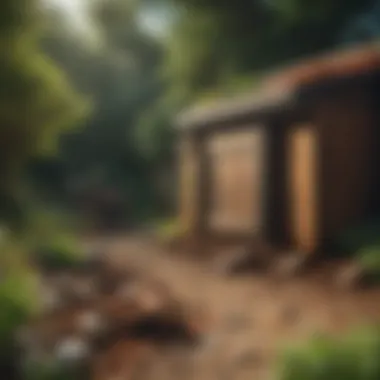

Maintaining Optimal Temperature
Temperature plays a critical role in the speed of composting. When conditions are right, the microbes would be more active and able to break down materials in a timely manner. Therefore, keeping an eye on the temperature of your compost pile is essential.
- Ideal Range: For effective composting, you generally want to aim for a temperature between 130°F and 160°F (54°C - 71°C). This range promotes an environment conducive to microbial activity.
- Insulating Your Pile: In colder months, a pile can lose heat quickly. Employing materials like straw bales or even old blankets can help insulate and retain warmth.
- Regular Monitoring: Use a compost thermometer to ensure you're within that golden range. If it dips, turning the pile can help mix in some cooler material and give your microbes a kickstart back to business.
Optimal temperature is the secret sauce that makes your compost pile go from trundling along to zooming through the breakdown.
Composting in Small Spaces
Composting in small spaces is not just a passing trend; it's a necessary adjustment in our urbanized world. As cities keep expanding and populations swell, the idea of utilizing every available inch becomes a priority. Even if your living situation consists of a studio apartment with barely enough room for a plant, there's no need to overlook the ability to compost. The benefits of composting in limited spaces are vast. For starters, by managing organic kitchen waste, you're actively contributing to waste reduction, meaning fewer materials end up in landfills. Plus, the nutrient-rich compost you produce can significantly enhance any green patch or pot indoor plant.
When it comes to small space composting, a little ingenuity can go a long way. You might be surprised at the range of methods available that fit seamlessly into a tight nook or corner. Before embarking on your compost journey, keep in mind a few critical considerations: airflow, moisture, and materials. Balancing these factors is key to successful composting, even in a confined area. Let’s dive into the techniques that can make your composting dreams a reality.
Compact Composting Solutions
For those keen on composting without taking up too much space, opting for compact composters can be a game-changer. Whether you’re considering tumblers or specialized bins, each option has its merits. Tumblers allow for easy mixing—this is essential for aeration, which speeds up decomposition.
A noteworthy mention is the Tumbling Composter. This style of composter rotates with a simple push. This movement not only mixes materials effectively but also introduces oxygen that’s crucial to decomposition. When working with limited space, the vertical or stackable composters definitely come into play. They allow you to create a multi-layered system, making the most out of vertical height. As you fill the top layers, materials in lower layers will break down, utilizing space efficiently.
Moreover, if you're an apartment dweller, look for countertop composters. These are compact, usually enclosed, and designed to fit right on your kitchen counter. The more modern models come equipped with odor-controlling technology. They can conveniently fit kitchen scraps like vegetable peels and coffee grounds, slowly breaking them down into rich compost over time.
"You do not need a yard to contribute to a greener planet; small actions in small spaces matter."
Indoor Composting Options
Indoor composting opens the door to possibilities without bulky setups or outdoor gardening. One popular method is vermicomposting, which employs worms to decompose organic materials. The bin can fit neatly under a sink or closet. The Red Wiggler worms are particularly effective, producing nutrient-rich castings.
For those not fazed by a bit of science, bokashi composting is another innovative option. Bokashi uses fermentation rather than decomposition. You simply layer food scraps in a bin with bokashi bran. It’s compact and effectively manages a variety of scraps, including meat, which traditional composting doesn’t always accommodate. Plus, this method generates a slightly acidic brew that can be diluted and used as fertilizer once it’s done breaking down.
Finally, there's the self-watering planter. This dual-purpose approach allows you to handle composting while also housing your beloved plants. You can create a bottom layer for your kitchen scraps, and the plants above will benefit from the nutrients leaching out. It's a win-win for space and functionality!
Each of these indoor options can turn a cramped environment into an eco-friendlier space, making composting accessible regardless of your living situation.
Exploring Community Composting
Composting, a practice that transforms spent kitchen scraps into rich, fertile soil, holds significant promise for both individual gardeners and broader communities. Exploring community composting goes beyond the solitary confines of your backyard. It brings people together to tackle waste management in a more collaborative, sustainable manner. Community composting taps into the collective effort to combat food waste by sharing resources, knowledge, and the rewards of enriched soil. In cities where space can be limited, these initiatives not only serve as a practical solution but also foster community spirit and connection to nature.
Joining a Community Compost Initiative
Getting involved in a community compost initiative can be a game changer, both for your gardening endeavors and your sense of participation in a larger ecological movement. These initiatives often welcome volunteers of varying skill levels. Whether you’re a seasoned composter or just starting out, there’s usually room for everyone. Local environmental groups, garden clubs, or city-sponsored programs frequently host composting workshops or set up designated composting hubs. When you join, you not only learn about efficient composting techniques but also share your firsthand experience and insights with others.
In many towns, you can find community compost bins in local parks or public gardens where residents can drop off their kitchen scraps. However, before diving in, it’s advisable to understand the rules. Most programs specify what can and cannot go into the bins. Familiarizing yourself with these guidelines ensures that the composting process remains effective and does not attract unwanted pests.
When you participate actively, your contributions can lead to significant quantities of compost produced, nourishing community gardens or local green spaces. It’s a true win-win: you reduce your waste, and the community benefits from a shared resource ready to revitalize its soil.
Benefits of Community Collaboration
The benefits of community collaboration in composting are hard to overstate. When individuals work together, they can achieve results far beyond what one could do alone. Here are some advantages:
- Resource Sharing: Community composting allows access to larger composting equipment or facilities that may not be feasible for individual households. Larger composters can handle more organic waste, speeding up the decomposition process.
- Diverse Inputs: A community initiative usually collects a variety of organic materials. This diversity contributes to a richer compost mix, promoting the production of high-quality fertilizer.
- Education and Awareness: Collaborating with others creates opportunities for learning. Workshops, discussions, and events can provide guidance on best practices, troubleshooting issues, and even the latest trends in sustainable gardening.
- Building Connections: Community composting brings together people with similar interests and values. It creates a network of relationships, fostering friendships and partnerships that extend into other areas of life, such as conservation or local food production.
- Environmental Impact: These initiatives collectively reduce landfill waste and lessen the carbon footprint associated with transporting waste. The aggregated effort has a significant positive impact on the environment, helping local ecosystems thrive.
"Community composting is the perfect blend of waste reduction and community building, exemplifying how small, local efforts can make a big difference on a global scale."
As urban areas expand and issues of waste management continue to rise, engaging in community composting provides a pathway not only to sustainability but also to community ties. It empowers individuals to take tangible steps in reducing their ecological footprint while contributing positively to the environment around them.
Ending: The Future of Composting
As we look ahead, the conversation around composting is gradually shifting towards a more sustainable and eco-conscious approach. The importance of composting kitchen waste stretches far beyond simply enriching soil; it encapsulates a fundamental shift in our relationship with food and waste management. By embracing sustainability and responsible waste management, individuals and communities are not just addressing the larger issues of landfill overcrowding and organic waste disposal; they are also contributing to a healthier ecosystem and minimizing their carbon footprint.
Sustainability and Responsible Waste Management
At its core, sustainability entails practices that meet present needs without compromising future generations' ability to meet theirs. In the context of composting, this means developing systems that can handle organic waste effectively while promoting the recycling of nutrients. When kitchen scraps are composted, they return nutrients back into the soil instead of taking a one-way trip to the garbage dump. This not only nourishes our plants but also closes the loop in our consumption cycle.
- Reduces Landfill Waste: Composting significantly reduces the volume of material that ends up in landfills, where it decomposes inefficiently, often leading to the release of greenhouse gases such as methane.
- Improves Soil Health: Adding compost to the soil not only enriches it but also aids in moisture retention and soil structure, promoting a vigorous ecosystem beneath the surface.
- Encourages Biodiversity: Healthy soil encourages diverse plant life, attracting beneficial insects and microorganisms, which in turn support a more balanced ecosystem.
In our current landscape, with increasing awareness about the environment, composting is evolving into a vital practice not just for individuals but for communities as well. By consciously managing our waste, we take an active role in reducing environmental degradation.
Encouraging Composting Practices
To make composting a common practice rather than just an ideal, several strategies can be employed. First, education is crucial; when people understand the simple act of composting can lead to profound environmental benefits, they are more likely to participate. Engaging the community through workshops can break down barriers and misconceptions about the complexity of composting.
- Community Challenges: Local governments and organizations can promote composting through community challenges, where neighborhoods compete in reducing waste and increasing compost output. Friendly competition can spark enthusiasm and participation.
- Incentives for Participation: Offering discounts or subsidies on compost bins or participating in local composting programs can encourage more residents to jump on the bandwagon.
- Social Media Campaigns: Sharing success stories and practical advice on platforms like Facebook and Reddit can build a sense of community among composters, highlighting notable achievements and organic gardening results.
"Composting isn’t just about discarding scraps; it’s about cultivating a culture of sustainability that nurtures our planet and future generations."
In summary, the future of composting hinges on fostering environments that encourage sustainable practices within our households and communities. By investing time and resources into composting education, we pave the way for a greener tomorrow, enriching our gardens and nurturing our landscapes, all while promoting a sustainable lifestyle.







